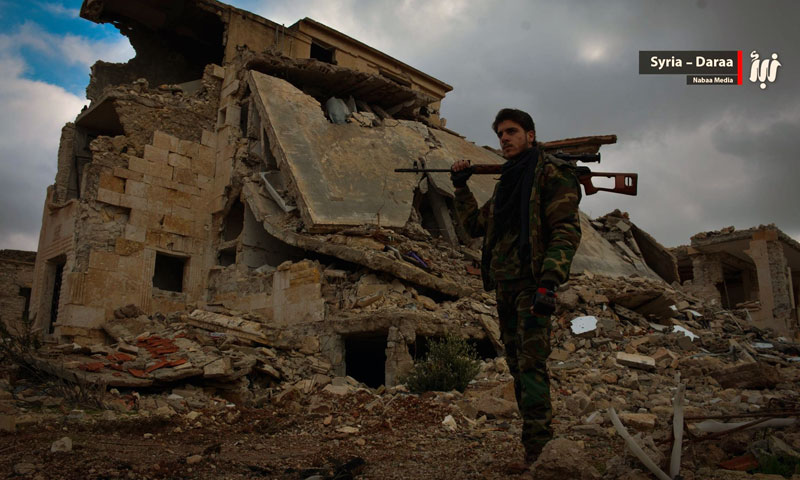The agreement that provided for reinforcing the “de-escalation” areas in Daraa governorate has reached its last days. The word “temporary” dominated the scene, for it was the most remarkable of all the agreement’s provisions, carrying a clear indication that the area might, at any moment, burst into flames immediately after the expiry of the agreement.
Despite the statements that Jordan’s Minister of State for Media Affairs, Mohammad Al Momani, has issued, saying: “The agreement is a crucial step within the tripartite joint efforts that aim to stop violence in Syria.”
The signals sent by Assad’s forces about the agreement being “temporary” had a negative impact on the people in Daraa governorate; for the past months, they lived in a state of suspension, no peace and no war, witnessing the failure of the agreement that joined Eastern Ghouta and Idlib governorate.
The Countdown is Starting!
Assad’s forces started following a new approach with the agreement being close to expiry; they used the policy of intimidation, which they directed towards the areas under the control of the opposition in Daraa governorate through repetitive confirmation that the “countdown” would be starting on the tenth day of February, on which the agreement would be annihilated.
The intimidation policy was manifested in threatening the city of al-Sanamayn, in the northern countryside of Daraa, considering “the rehearsal of evacuating the city for a few hours as a miniture of what the city will be living incase it refused to reconcile,” according to what a source, close to the Assad’s forces 9th Armoured Division, has told Enab Baladi, after the hours’ long stress that the city underwent following a statement by Assad’s forces that announced evacuation in preparation for the incursion, before it withdrew the statement, shifting to a language of high-pitched threats.
The source added that Assad’s forces demanded the inclusion of the city in the reconciliation process and handing over the weapons; it also threatened that the deadline is the 10th of February, after which force would be used since the “de-escalation” agreement would be already finished by then.
The source indicated that this was the first time that the Syrian regime uses such a language with the city, pointing that “it might be an introduction for a battle that is being prepared [to be launched] when the agreement ends in the northwestern countryside of Daraa, and that the city of Al-Sanamayn is only the beginning.”
The source also confirmed that what Assad’s forces have been spreading about one of their element’s being kidnapped in the city is only a “lie,” aiming to create a pretext to elevate stress and pave the way for their plan.
Days before the threats, Assad’s forces returned many of their forces to the vicinity of the Al-Sanamayn, after they had sent them for weeks to participate in the battles of the city of Harasta in eastern Damascus, a thing that increased the state of anticipation in the city.
From Jasim to Al-Sanamayn
Not that far from the city of al-Sanamayn, Assad’s forces are applying pressure on the city of Jasim, despite that fact that it is not witnessing a siege like al-Sanamayn. However, the threats about the close expiry of the “de-escalation” agreement is the common factor between the two cities.
Assad’s forces are planning to “distance the city from the battles that the area might witness and to prevent the factions from using it in the battles,” according to Abu Mahmoud al-Jabbawi, a man from the city, who is informed of Assad’s forces threats.
Al-Jabbawi told Enab Baladi that the threats have been sent by a number of mediators, and Assad’s forces asked for including the city in the reconciliation process and distancing it from the battles.
Al-Jabbawi pointed out that the Syrian regime is trying to neutralize all the major cities in the Jaidour area from the anticipated battles in the northwestern countryside of Daraa by threatening them with shelling, adding that: “They are trying to deliver messages, that if the people prevented the opposition factions from using the city during the battles, they would not have to endure shelling,” as a form of direct pressure on the popular incubator of the opposition’s factions.
The regime has been using the end of the “de-scalation” agreement as a pretext for all the military operations against the city of Jasim, according to al-Jabbbawi, who pointed out to the same date that has been used to threaten the city of Al-Sanamayn, “they told the mediators that after this date (February 10) they will be shelling any city that shows a military movement on the part of the opposition factions.”
The “de-escalation” agreement has after all been in the favor of the Assad, for it stopped certain fronts and inflamed others. Since the ceasefire and the “de-scalation” agreements entered into force in Daraa governorate, in the second half of the last year to February 2018, the control map in Syria has changed a lot for the advantage of the Syrian regime, especially in the north and the east.
The map preserved its borders in the south, and the opposition factions, in Daraa, favored to keep a distance from action, while most of the analysis indicate that Daraa will be the heart of action in the upcoming phase.

